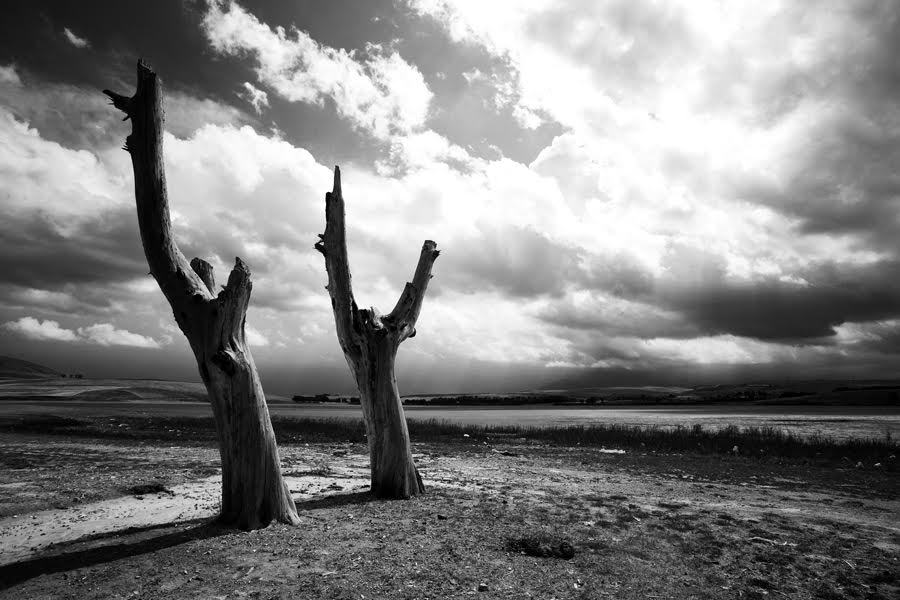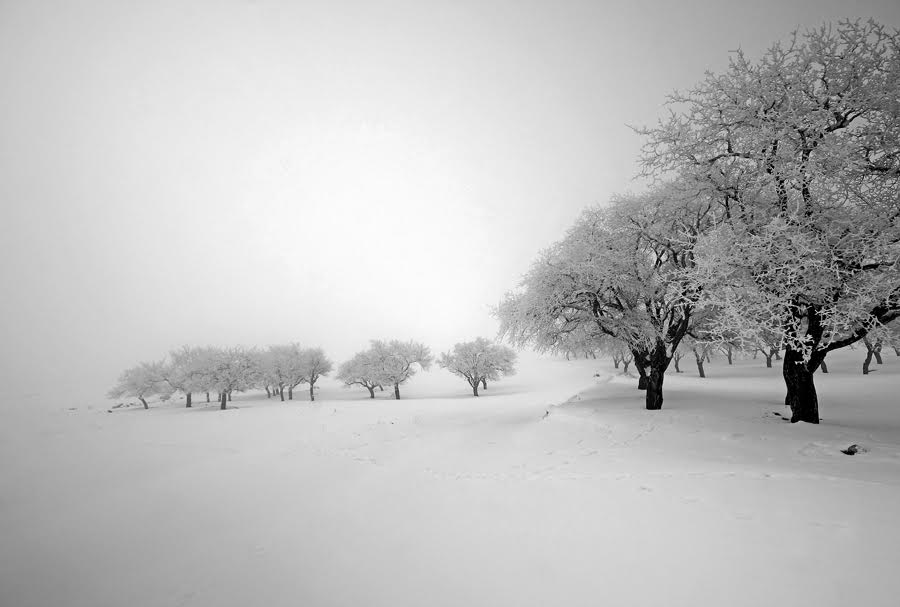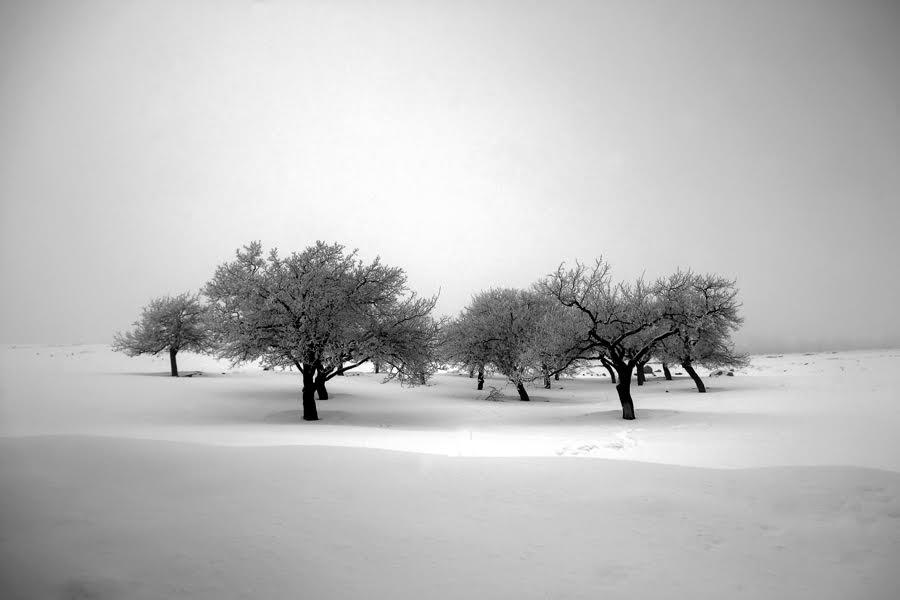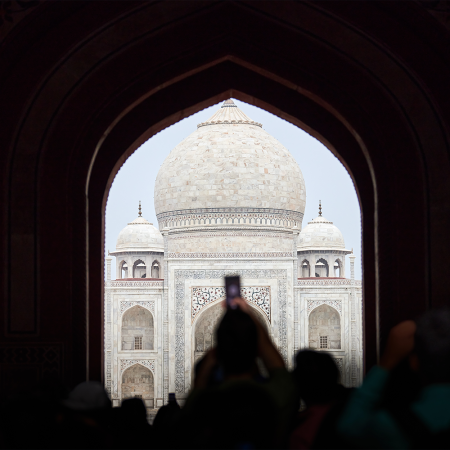There is something silent about the photographs that Ali Shokri takes of trees.
Silent in that their stillness is audible. Just look at each image of snow or sand or slope: the long thick tree limbs that reach and twist toward the sky, roots spread out beneath the surface of the ground. In their silhouettes and shadows, they tell the story of a fading landscape, dark against the lightness of day, ominous and solitary and sparse. While there is beauty and angst in their inky, crooked limbs, the trees always seem like they are too few. Overwhelmed by the negative space that surrounds them. Alone.
The real subject of these photos might not be the trees we see, but the ones we don’t. What is happening to these landscapes? What will happen if all the trees disappear?
Shokri is a modern-day Lorax of sorts. He has been photographing trees in his native Iran and nearby Azerbaijan for the last 16 years. In 2017, his book The Passion of Trees collected 111 of these images. “I know I can’t save our trees with my photographs, I can’t restore nature to her imperious verdure,” Shokri tells InsideHook via email. “Yet I try to capture the lonesomeness and exile of the trees and encourage the viewers to look at nature with a different gaze, to remember that in the absence of trees the birds are homeless and there’s no air to breathe, to remember that if there are no trees, humanity has already vanished.”
Nature has been important to Shokri from a young age. His family moved often, and at each new home, his father would plant a tree in the yard, trusting his children to water it. Later on, Shokri became an avid mountaineer and nature tour leader. For him, as it is for so many, the tree became a symbol of life.
In 2003, when he left his path as an IT engineer to pursue a life in photography, trees and the natural world in general became a perpetual muse. “[When] I started photographing trees, I believed in the beauty and vitality of the human life cycle and was keen to capture that beauty and show my interest in the details of trees over time,” he said. “After a year, I realized that I had a particular interest in trees and felt that they had unique emotions like human beings, so I came across a human element, and I finally realized that the trees were carrying messages along with their [beauty].”

Shokri’s work became not just an act of depicting natural splendor, but a form of environmental activism. Perhaps unsurprisingly, one of his primary influences is famed American landscape photographer Ansel Adams: “I felt that Ansel Adams’s nature photos were not just beautiful nature pictures,” he said. “They had a message that mattered to me.”
Adams is still regarded as one of the greatest landscape photographers in history, and also famously blended his love of photography with his love of nature. “When people thought about the national parks of the Sierra Club or nature of the environment itself, [they[ often envisioned them in terms of an Ansel Adams photograph,” wrote William A. Turnage, environmentalist and Adams’s former manager, in 1999. “His black-and-white images were not ‘realistic’ documents of nature. Instead, they sought an intensification and purification of the psychological experience of natural beauty. He created a sense of the sublime magnificence of nature that infused the viewer with the emotional equivalent of wilderness, often more powerful than the actual thing.”
Shokri’s work doubtlessly seeks to elicit the same feeling, and succeeds. It is more than mere documentation: it transmits an emotional and physical feeling, of standing quietly in the wilderness, listening to the wind whip past broken branches, mourning what used to be while also absorbing the paradoxical grace in destruction.
While Shokri completes his work with a trusty Canon 5D (Adams, of course, shot film), the majesty of nature and the urgency of its preservation ultimately drive the work of both artists. Using black and white, just as Adams did, Shokri evokes the sorrow of the depleted natural landscape in Iran the way Adams captured the majesty of its lushness in the U.S. Shokri equates black and white with sadness and grief, and the stark contrast in the images makes the concept easier to understand. “I feel as if the trees, bundled at the back of trucks, are cursing us with their broken hands, wounded faces, and severed roots,” he says.

Shokri’s work is especially timely now. Even though the 194,000+ acres of Iran’s Arasbaran forests are a UNESCO World Heritage Site, the area experienced devastating fires in August 2019. It destroyed more than 740 acres of the once lush areas that were home to 20 percent of Iran’s plant life, including tree species rare to the region like Junipers and European Yews. Sadly, it wasn’t the first time the region encountered such damage: it had caught fire another 24 times in less than six months before that. Add to that Iran’s troubles with water crises and pollution, and the country faces a treacherous mix of environmental threats.
Across the globe, deforestation — whether driven by humans or by natural disaster — is taking a horrifying toll on the planet. According to National Geographic, between 1990 and 2016 the planet lost 502,000 square miles of forest, an area just larger than that of South Africa in size. “I cannot imagine the depth of his sorrow if father were alive and could see how the walnut trees have dried out and the apricots do not blossom anymore,” Shokri says. “To me, each tree, like a human-being, has a tale to tell. When a tree dies, a whole story is interrupted, a destiny is altered for the worse.”
While the greys and blacks and whites of Shokri’s images make for beautiful photographs, deforestation itself is far from beautiful. But by drawing our attention to the devastation, Shokri’s work reminds us that there’s still an option to move forward, to make change, to preserve what’s left. “For the foreseeable future, my work is to show human ecosystem changes that will happen to humans in our lives, and also to portray the message of defenseless and speechless creatures and to the audience,” Shokri says. “Imagine that there is no tree.”
This article appeared in an InsideHook newsletter. Sign up for free to get more on travel, wellness, style, drinking, and culture.
























